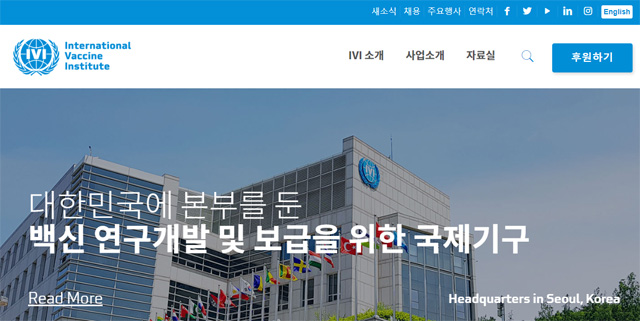Korean Broadcasting System (KBS) News published an article featuring Dr. Manki Song, Deputy Director General of IVI’s Science unit, to discuss global efforts to create a vaccine against COVID-19. Read translated excerpts from the full article below.
When will a vaccine be developed? When can we expect the “Super Vaccine”?
February 11, 2020, KBS News
Along with the outbreak of the novel coronavirus (COVID-19) epidemic, good news is also on the horizon. Following in the footsteps of China, France, Singapore, and Germany, Korea has also succeeded in isolating viruses and is racing to develop vaccines and treatments. Vaccines induce immunity before the virus penetrates the body, and therapeutics treat the virus.
It looks as if the highly-coveted ‘Dream Vaccine’ will emerge anytime soon, but this does not mean that it can be commercialized immediately. The vaccine may not be completed even after the virus has dropped off, which means there is a myriad of obstacles to overcome. Dr. Manki Song, Deputy Director General of Science of the International Vaccine Research Institute (IVI), gives answers to our questions about a novel coronavirus vaccine.

When will the development of a vaccine be deemed completed?
The international community, both private and public, is working to combat COVID-19. The Coalition for Epidemic Preparedness Innovations (CEPI), an international cooperation body against infectious diseases, has partnered with the US National Institutes of Health (NIH) to actively support finance and technology for vaccine development. In addition, researchers in Australia and Hong Kong, as well as private companies such as NovaVax and Inovio have started efforts to develop a vaccine.

The Coalition for Epidemic Preparedness Innovation (CEPI) is an international collaboration focusing on eradicating infectious diseases that has begun to develop new coronavirus vaccines.
…
The KCDC succeeded in isolating the virus from infected people and decided to distribute them to related organizations. Securing the virus makes it possible to study how the virus differs from SARS or MERS in the past, and how it is affected by temperature or humidity, and to find anti-viral treatments among candidate drugs.
Vaccine development is not technically difficult, with extensive research efforts already underway, but it’s unknown whether it can be applied to the ongoing epidemic immediately. Currently , the world is only moving from the phases of preclinical to clinical trials, with Phase I clinical trials in at least 20 people expected to take three months. It will take a ‘minimum of one year’ to complete clinical trials and validate the safety and effectiveness of the vaccine.
In order to complete the development of a vaccine, the vaccine should complete 3 phases of clinical trials. Phases 2 and 3, which need to be validated in hundreds to thousands of people. Phase 3 trials are significantly different. That’s why we come to hear news of plunging stock prices after Phase 3 clinical trials. The development of a vaccine usually takes eight to ten years, from finding candidate vaccines to clinical trials. The reality is that after licensure, there is another ‘challenge’ of mass production.
Starting in the United States recently, they streamlined the procedures to enable Phase I clinical trials within six months. For technologies that have been validated for safety, the regulatory authority could exempt toxicity testing. This is because infectious diseases have often disappeared before the vaccine was brought to market. The streamlined procedure will also apply to the ongoing epidemics. What would happen if the vaccine you developed prove to have no value? They invested a lot of time and money, but in many cases such vaccines failed to save lives and were discarded.
…
Viruses disappearing after unpredictable epidemics –International organizations and countries must take the lead to develop vaccines:
Although uncertainty is still high, the new coronavirus, like SARS and MERS, is likely to go through the process of spreading irregularly and then disappearing. The current situation is mainly limited to China, and the trend of infection seems to be dropping off, making it difficult for pharmaceutical companies to jump “all the way on board” towards developing a vaccine.
Seasonal flu caused by the influenza virus has a worldwide epidemic pattern every winter. When the World Health Organization (WHO) announces a new strain of vaccine every year, providing the required the supply of vaccines is therefore an attractive market for pharmaceutical companies.
There is a high voice in the development of vaccines driven by market logic, and therefore by international organizations and countries at the public level rather than the private sector. Infectious disease damage is concentrated in poorly hygienic underdeveloped countries, and especially kills the underprivileged.
There’s a growing voice in the market-driven vaccine industry that international organizations and countries should step up to develop a vaccine on a public level rather than looking to the private sector to do so. The harm caused by infectious diseases is concentrated in underdeveloped countries where sanitation is poor, and is especially detrimental to the lives of the underprivileged.
CEPI was launched in 2017 with the aim of developing and stockpiling vaccines in advance to address the dangers of potential epidemics. It is funded by the Gates Foundation, Norway, Germany and Japan, and collaborates with multinational pharmaceutical companies. In addition to the new coronavirus, it is leading the development of vaccines against viruses such as MERS, Ebola, Nipa and Lhasa.
The International Vaccine Institute in Korea is also conducting research thanks to funding that include donations. Korea has additionally succeeded in developing its own chickenpox, shingles, and influenza trivalent and tetravalent vaccines; and based on current know-how, the National Institute of Health of Korea has recently decided to invest 800 million won in a push to develop new coronavirus vaccines and treatments.
Read the full article in Korean here.





